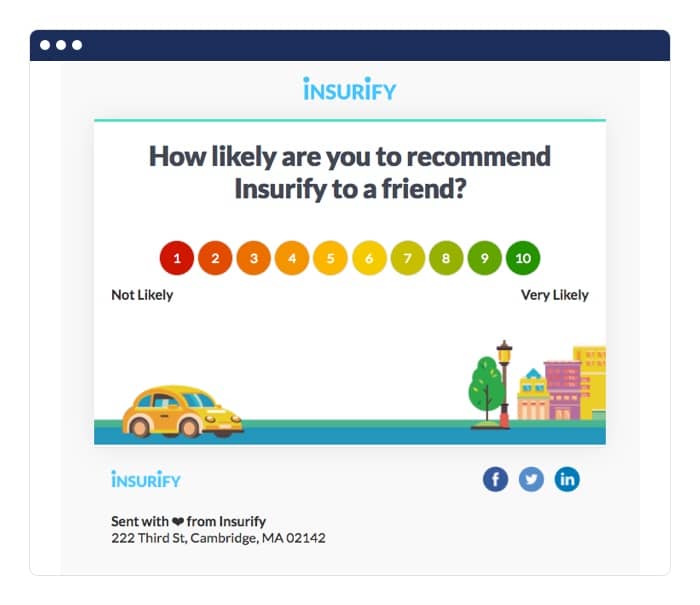- All Posts
- /
- Retention marketing strategies that boost revenue

Retention marketing strategies that boost revenue
Messaging and Automation-
 Stephanie Knapp
Stephanie Knapp
-
Updated:Posted:
On this page
Customer relationships are like a flywheel—they require effort to get them started, but once they’re spinning, it’s easier to maintain. Acquiring a new customer takes hard work. After all, people aren’t likely to buy from you the first time they see your company.
Once you do win them over, though, you can reap the rewards of that relationship through retention marketing.
Marketing retention strategies are focused on keeping customers happy to prevent churn, and increase account expansion and advocacy. To do this, you begin each customer relationship with a long-term view and focus on helping users achieve their goals.
The benefits of retention marketing include:
Increased revenue
- Nearly 40% of consumers will spend more on a product with a company they’re loyal to, even if there are cheaper options elsewhere.
- The average value of a lost customer is $243.
- Increasing retention rates by 5% can increase profits by 25% to 95%.
Better customer insights
- 63% of consumers would share more data with a company that offers a great experience.
- Customer advisory boards with engaged users can provide actionable feedback.
- Tracking retained customers over time gives you more insight into the user journey
Easier expansion
- 60% of customers will tell friends and family about a company they’re loyal to.
- Word of mouth marketing is a primary factor in up to 50% of purchases.
- Upselling is 68% more affordable than acquiring a new customer.
Sound intriguing? Let’s get started.
Exploring the new marketing funnel
The best retention marketing strategies begin before a customer ever converts. Rather than basing your strategy on a marketing funnel that focuses on the buyer’s journey, from awareness to purchase, you have to expand your horizons.
The new marketing funnel actually looks more like a bow tie. How it works is the “buyer journey” funnels downward from awareness to purchase, and the “customer journey” expands from adoption to advocacy.

By planning all marketing with the end goals of retention, expansion, and advocacy, you can make decisions that have long-term customer benefits, not just cheap acquisition wins. Acknowledging what needs to happen after the sale also helps you plan how to keep users engaged.
We have a starter’s guide to customer experience management here, which teaches you how to audit and improve touch points to exceed customer expectations. In today’s post, though, we’re going to explore the tactics and tools you can use to increase retention.
Customer retention marketing best practices + inspiration
Above all, retention marketing is a mindset. Your best chance at retention success is getting everyone—from teammates in the weeds to the C-suite—excited about helping customer success in the long run.
Here are seven tactics you can use across your marketing channels to keep customers happy and engaged.
Onboarding program
The customer journey begins with adoption, which is rooted in onboarding.
Customer onboarding is so critical because it lays the foundation for your customer relationship and success. Without a process to get new users started on the right foot, you risk losing the momentum that led them to sign up in the first place, which can lead to churn.
Duolingo actually begins their onboarding process during signup, with a focus on identifying a user’s “why.”
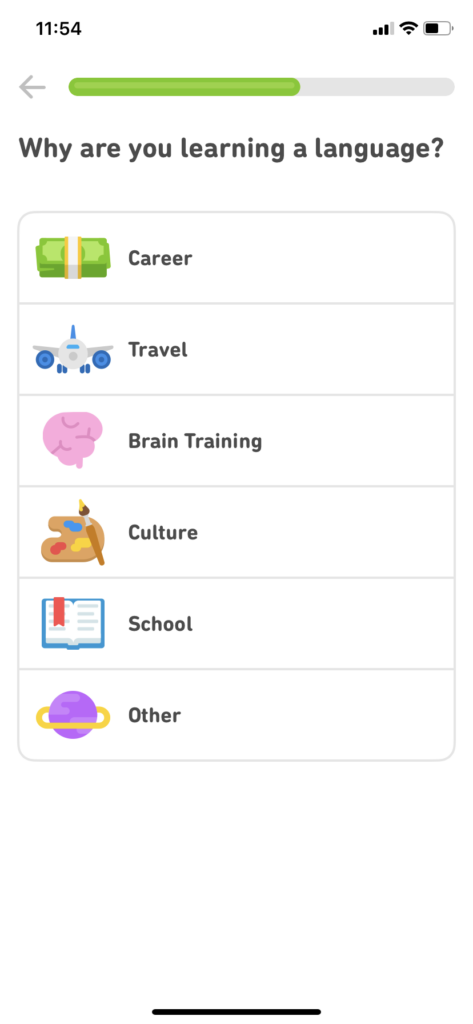
Users sign up for your product because they want to accomplish something, and the earlier you can identify that, the sooner you can begin genuinely getting them to their “aha moment.”
During sign up, Duolingo asks you what your usage goals are, as well as why you want to learn a language. By understanding a person’s motivations, as well as how serious they are about achieving their goals, the company can tailor their engagement approach.
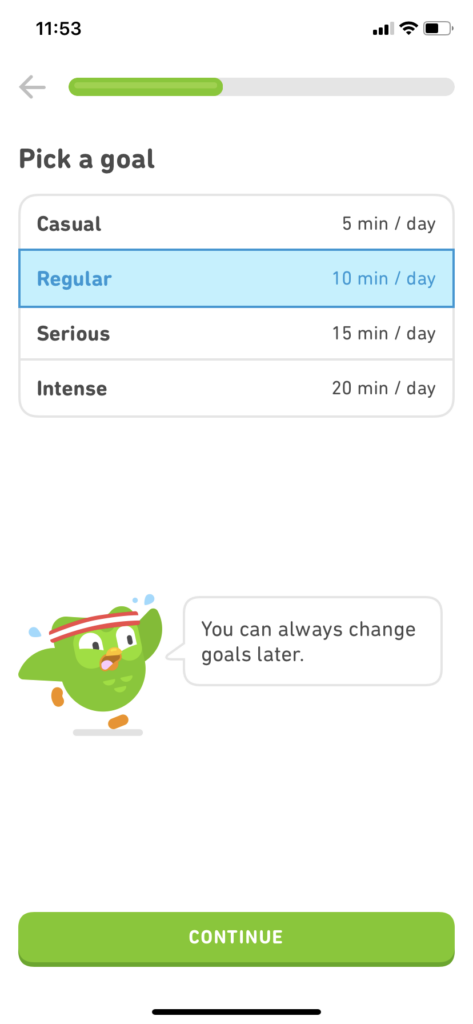
To apply this, identify touchpoints where you can ask or infer a user’s goals. Then use this information to position important features or send relevant content.
Read More: Customer Onboarding: A Data-Driven Approach
Customer loyalty program
Customer loyalty programs are useful for keeping users engaged and increasing customer base, especially for eCommerce brands. Bracelet company Pura Vida uses multiple customer loyalty and rewards touchpoints to boost retention.
Their monthly subscription program, Pura Vida Bracelet Club, offers three exclusive bracelets each month. The catch? You have to act fast to get in on this month’s offer. Creating urgency to join a recurring subscription works to provide Pura Vida with a more reliable income stream.

How exactly does this monthly club build loyalty, though? Well, two of the top eight factors that influence brand loyalty have to do with sharing gifts and the most up-to-date offerings. While an average loyalty program focuses mostly on gifts and offers, brands can gain even more loyalty by building community.
Going above and beyond to create a program with a sense of belonging through helpful support, informative content, and collaborative engagement will get you far. The more you invest in building a community that’s “bigger than your brand” (one that isn’t solely focused on money), the more brand affinity you’ll build.
Loyalty is a two-way street, and the more you put into the relationship, the more you’ll get out of it.

Newsletter
Not ready to add entirely new initiatives like customer loyalty programs? How about an upgrade to your email newsletters? These recurring emails keep subscribers up to date, but they can also keep users engaged.
GitHub uses its newsletter to educate readers on a variety of topics. While they do use emails to promote new content with links, there’s also an “Ask Hubot” that offers advice with no strings attached. By providing so much value and information in the email, GitHub positions itself as a knowledgeable resource and not just a tool.

Asana uses the newsletter below to highlight their community. Presenting new use cases can re-energize users by educating them on new ways to use the same tool. As the email highlights how the company itself uses its product, it also gives readers a behind-the-scenes look into the people running the show.

Read More: Email Newsletters: Why they’re effective and how to create your own
Customer education
If you liked the education aspect of the Github newsletter, then you’re going to love these examples from Shopify. Customer education resources ranging from free courses to live workshops and templates can help users be more resilient. In Shopify’s case, they offer free courses and guides across all of the skills their users may need.

Are you facing an issue using a product? Head to a community forum to talk to people who can relate. Need to level up your skills? Try consulting a company’s knowledge base or free courses. As we mentioned previously, investing in educating your community positions you as a partner in their success.
Plus, providing resources to help customers overcome hurdles and increases the chance that they’ll stick around and see their problem through.
Referral programs
While formal customer loyalty programs are sometimes better suited for eCommerce brands than software companies, everyone can benefit from referral programs. For example, Dropbox rewards its users with free space when they invite friends to join.
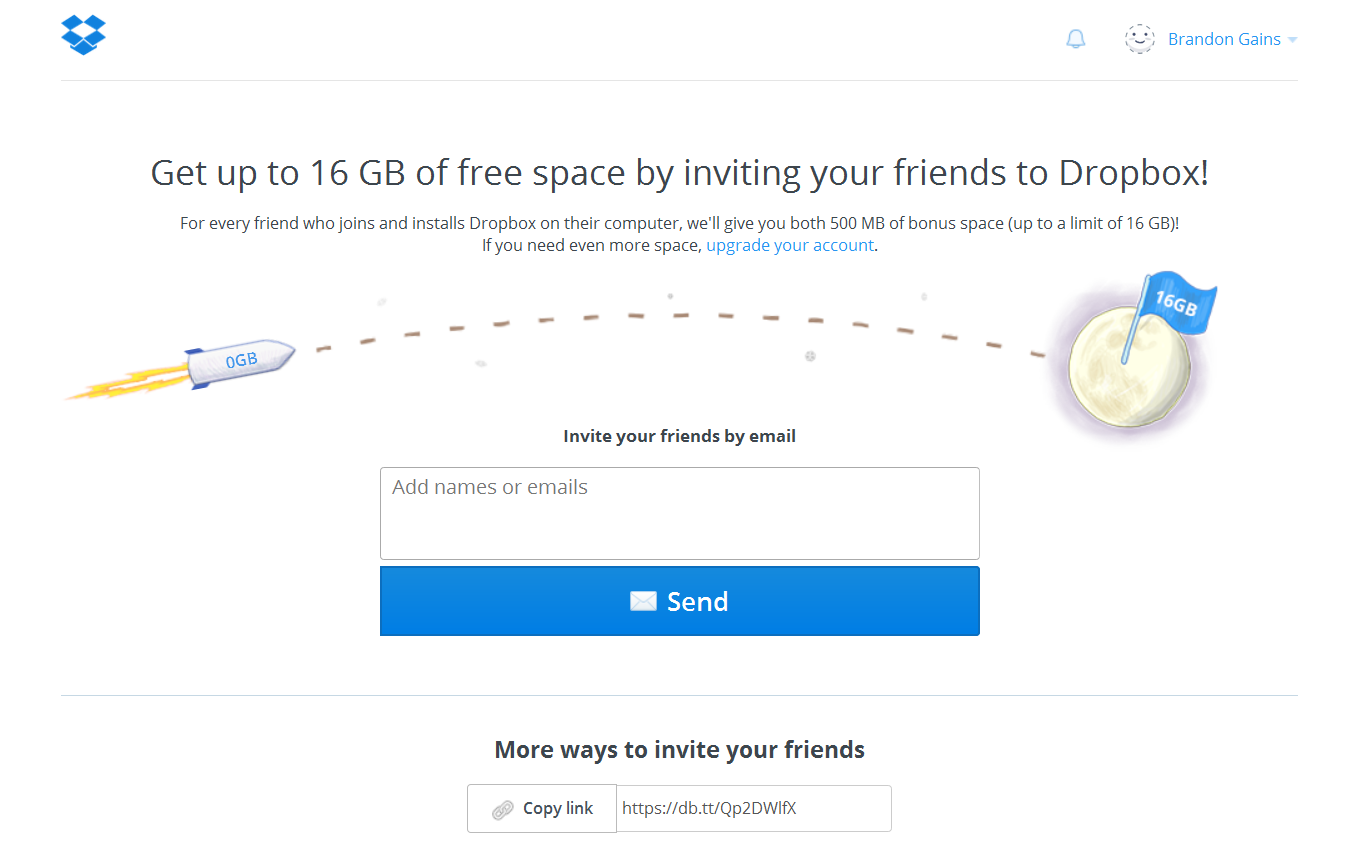
The company’s “double-sided” referral, where both the existing and new customers receive free space, was very successful. Before the program, they were spending SEM and affiliate marketing to gain new users at a CPA of $288-$388 on a $99 a year product.
After the program, their signups permanently increased by 60% and 35% of daily signups are from referrals.
Read More: How to create great referral emails
Upsell emails
Another way to retain customers and boost revenue is to send upsell emails wisely. This means that your upsell offers need to be timely and personalized.
For example, Asana gives users a heads up when they’re approaching an account limit. Instead of just springing an upsell email on them once the limit has been reached, possibly sending the user into a panic, Asana gives them time to consider.
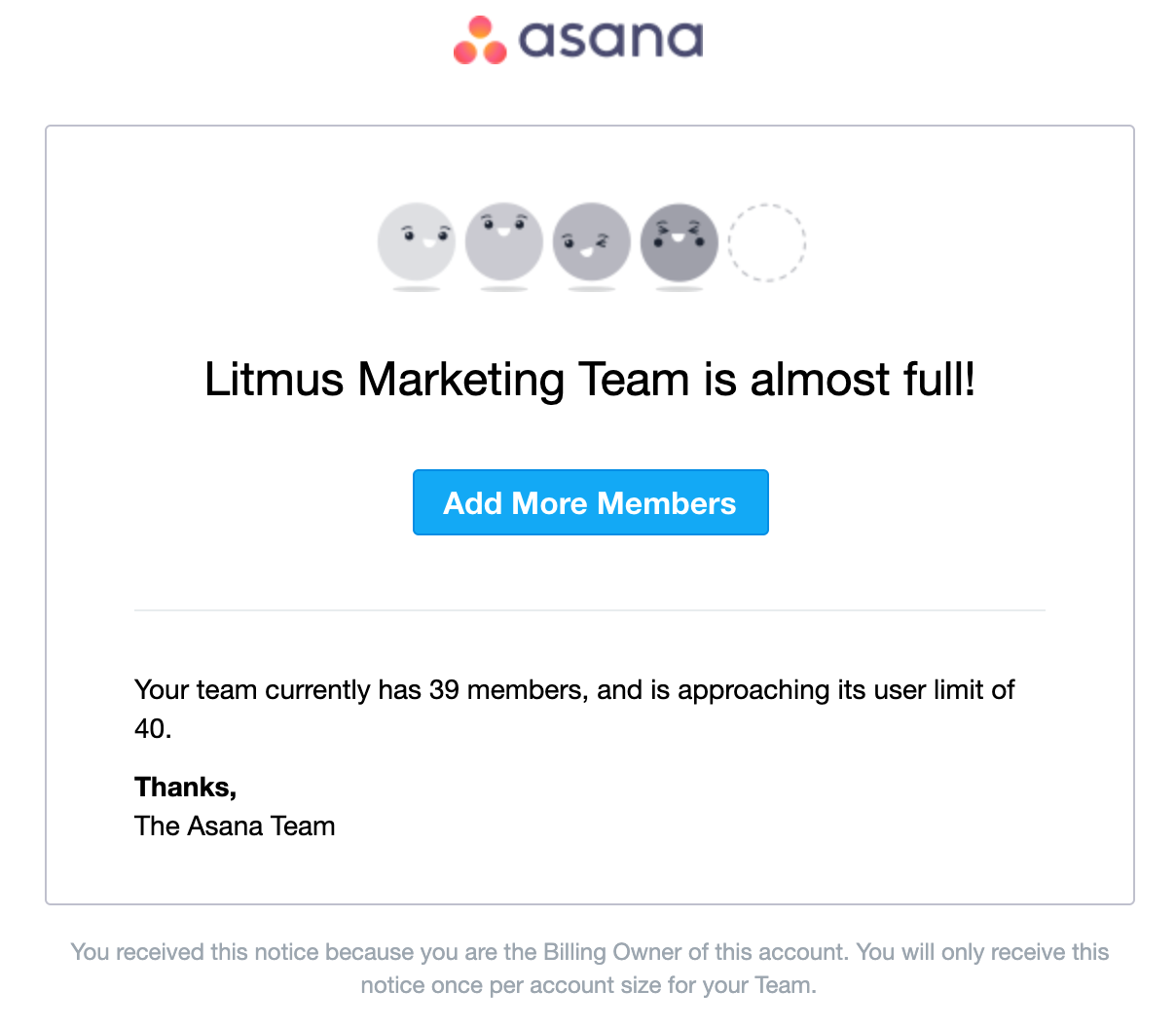
You should also personalize your upsell emails. In the example from Freelancer below, the company is recommending an upsell based on customer actions. Since the user had set up a project but not hired anyone to complete it, Freelancer took the opportunity to help a person along with a paid “recruiter” service.
By pairing the upsell with customer actions and goals, it feels less like a pitch and more like a helping hand.

Read More: Triggered Retention Emails That Keep Customers Engaged
Collect feedback
It’s nearly impossible to make improvements if you don’t know where you’re falling short of customer expectations. Therefore, collecting user feedback is a vital component of your retention marketing plans. The email from Scoot below is a bit of a feedback and winback combo.

The company noticed a drop in activity, so they sent an email to ask if there’s anything they could do to improve. This email can help retain the customer it was sent to, as well as provide insight into user sentiment as a whole. If you find recurring themes in feedback surveys, you may have a detail worth investigating.
Another way to collect feedback to boost retention is through customer advisory boards. These are groups of customers who are willing to provide feedback on an ongoing basis. Regularly meeting with your most engaged users helps you check company strategy against customer goals, as well as make sure users feel their voices are heard.
Read More: How to Collect Customer Feedback with Email
How to track retention rate marketing efforts
Ready to talk numbers? All of your hard work could go unnoticed if you don’t track results, so we’re going to break down the retention marketing metrics to pay attention to. These calculations will help you get a more granular view of what’s affecting your retention rate.
Want a refresher on calculating your overall retention rate? Check out our guide here.
Retention metrics for software companies
If you want to boost retention in your software company, your focus is on helping users build and maintain good habits. Therefore, retention marketing metrics for this business model are based on the frequency and consistency of actions. Here’s what you should pay attention to:
Login frequency
It’s natural for accounts to have some fluctuations in login frequency, but you should investigate spikes or crashes. A sudden drop in login frequency may benefit from a customer success check-in, while a steady decrease over time could use a re-engagement campaign.
| Timestamp | User ID | ccount ID | Activity | Module |
|---|---|---|---|---|
| 1/1/19 8:00 | 1000 | ACME | log in | gsuite |
| 1/1/19 8:01 | 2000 | ACME | log in | gsuite |
| 1/1/19 8:05 | 1000 | ACME | new doc | slides |
| 1/1/19 8:07 | 1000 | ACME | update | slides |
| 1/1/19 8:07 | 2000 | ACME | share doc | sheets |
| 1/1/19 8:08 | 3000 | XYZ | new doc | slides |
A sudden spike in logins should also raise your eyebrows. What caused the change? Are they logging in more because they’re using more features, or are they becoming frustrated and logging off again and again? You could send a survey to find out.
New team members added
Your accounts are growing—hooray! Users adding more team members to their accounts means they’re sharing the tool within their organization and having more widespread adoption. They may also now be candidates for an upsell, and you may need to send resources to new team members to help them learn.
Support tickets raised
Analyzing support ticket frequency can be tricky. On the one hand, you don’t want customers to be having such a tough time that they submit requests over and over.
On the other hand, silence doesn’t guarantee that a user isn’t having issues either.
Instead of looking at just the volume of support tickets raised, segment your analysis to add context.
For example, you can sort support tickets by type or topic. Preferably, you’d see more users asking for help on positive aspects of your business, such as a new integration or feature request. Support tickets about bugs and outages are signs of frustration, and increased volume of this type could correlate with churn. You can also review support ticket volume by customer segment or account type.
You should also analyze NPS ratings from users after they’ve submitted support tickets. Gauging sentiment after these interactions can let you know whether the issue was truly resolved and the customer is happy. To gather NPS scores, send a simple email like the Insurify example below.
Volume of key metrics
Every app has core actions that healthy customers should be taking regularly. For example, here at Vero, we expect to see users sending emails each week. If you have a project planning app, your key metrics may be tasks completed or projects updated.
Whatever your key metric is, track it for changes. If an account hasn’t taken action in a few weeks, a triggered email to get them back into the app can help.
Retention metrics for eCommerce companies
Healthy eCommerce retention and expansion is reflected in order frequency and volume. To tie retention to your marketing efforts, consider using cohort analysis to segment users based on the campaigns they’ve received, or their acquisition channel.
Repeat customer rate
Repeat customers generate sales without having to pay acquisition costs again. To calculate your repeat customer rate, determine what percentages of orders came from someone who has bought from you two or more times.

Instead of calculating this rate once and calling it a day, compare the numbers over time, such as in the graphic from Shopify below. How is your month-over-month and year-over-year performance? Does your repeat customer rate vary between product lines or customer segments?
All of these calculations can help you pinpoint profitable segments and campaigns to double down on.

Purchase frequency
Purchase frequency explores repeat customers a little further, and lets you know, on average, how many orders a single customer makes in a given timeframe. To calculate it, simply divide the number of orders by the number of unique customers. Remember to use the same time period, such as a month or a year, for each number.

Similar to your repeat customer rate, you can use purchase frequency to analyze customer retention across segments. If you have a loyalty program with automated emails, like Chipotle does, you can also monitor how often those triggered emails send.

Customer lifetime value
In addition to order frequency, you can use customer lifetime value to understand long-term engagement. Not only does this help you identify your most loyal customers, it also builds your case for retention.
If you know what your company stands to gain from keeping a customer around, then your retention efforts look even more enticing. Understanding customer lifetime value also helps you set limits for how much you’re willing to spend on acquisition and retention.
To calculate customer lifetime value, you’ll first need to uncover your average purchase value, purchase frequency, average customer value, and average customer lifespan.

For example, imagine your revenue last year was $1,000,000 and you had 10,000 unique customers. That means your average purchase value is $100.

While you had 10,000 unique customers last year, you processed 16,000 orders. That means your average purchase frequency is 1.6.

Using the two numbers you’ve just calculated, you can find your customer value. An average purchase value of $100 over a purchase frequency of 1.6 gives you a customer value of $62.50.

If you meet the average e-commerce retention rate of 28%, that means you have an annual churn rate of 72%. Using the equation above, your average customer lifespan would be 1.38 years.

Finally, the number you’ve been working towards. In our example, you would multiply the average customer value of $62.50 by the average lifespan of 1.38 years. In the end, you’d have a customer lifetime value of $86.25.
Once again, remember to make your time frames align in your calculations. If you use your total revenue from May, then you need to divide it by the number of orders for the same month.
Retention metrics for marketplaces
If you run a marketplace, tracking retention comes with a few more angles. Rather than simply looking at metrics such as order volume or site visits, you’ll use separate equations for demand and supply.
Marketplace demand metrics
Your marketplace demand metrics are all about buyers on your platform, and they’re very similar to what’d you use as an e-commerce company.
Repeat purchase ratio
A customer’s repeat purchase ratio is similar to purchase frequency in that it measures how often buyers come back for more. To calculate this ratio, you’ll need to know how many customers purchased from you more than once.
Average number of bids per buyer
If your marketplace works with bids, you should analyze the average number of bids per buyer. When a bidder is new to a marketplace, they’ll likely start with a lower number of bids. However, as trust increases and each buyer places more bids, you’ll need less buyers per seller to complete a transaction.

This evolution is displayed in the chart below. In the early stages, buyers bid infrequently, and you may need 100 buyers to every seller. As time goes on and the average number of bids per buyer increases, the ratio of buyers to sellers drops.

Demand liquidity
If potential customers are bidding or visiting way more than
they’re finishing sales, they’ll get frustrated. Therefore, you
should calculate what percentage of visits are filled or
matching their needs.

Marketplace supply metrics
Without sellers on your marketplace, you won’t be able to meet demand. Retention metrics for the supply side of your business are focused on seller activity.
Average number of listings per seller
Similar to gauging repeat purchases from buyers, you also want to measure repeat listings from sellers. The average number of listings per seller helps you establish a baseline to compare seller activity to.

Supply liquidity
Putting up a listing and not getting any takers won’t inspire sellers to stick around. In addition to tracking demand liquidity, you should also analyze what percent of listings are sold or booked.

Tools to measure customer retention
Now that you know which retention marketing metrics you should use in your business and how to analyze them, let’s cover a few tools to help you get the data you need.
Google Analytics
While it may not be the most specialized option, you can use Google Analytics, or whatever analytics platform you currently use, to study retention. Calculating your retention rate can give you an idea of how long users keep returning to your site, and the Loyalty features help you see how many highly-engaged users you have.

Mode
Mode is a data
analysis tool that allows you to create detailed reports and
visually explore user data. The tool has an SQL editor, and
Python and R notebooks, so technical knowledge is required. You
can access their basic analysis tools for free.

Amplitude
Amplitude
is a behavioral analytics platform that helps you understand
user behavior on your web and mobile sites. This type of tool is
particularly useful for SaaS companies who want to understand
the actions that drive retention. There is a free plan, though
you’ll need to upgrade for behavioral and predictive reports.

Looker
Looker has
product analytics tools for companies with varying needs and
tech skills. You can choose a “plug and play” solution that’s
easy to connect to your application, or scale up to tailored
tools and reports for deeper insights.
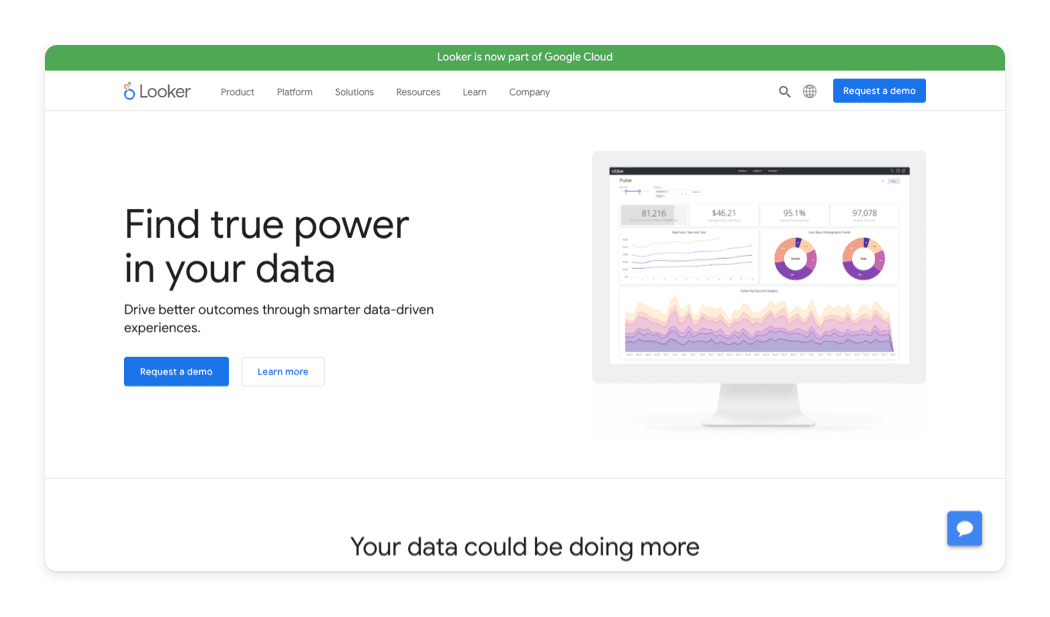
If you want to improve your retention rates, you have to take a customer-first approach. To do this, consider the entire buyer and customer journey and use behavioral data to trigger real-time marketing across channels.
Want to learn more about data-driven marketing? Read our guide to webhooks here. Then, check out how to send emails using real-time customer data with Vero.
